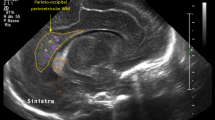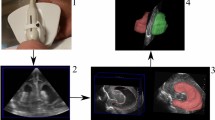Abstract
Objective:
To compare echogenicity detected using cranial ultrasound (cUS) and diffuse excessive high signal intensity (DEHSI) detected using magnetic resonance imaging (MRI) by identical region-based scoring criteria in preterm infants. To explore the association between these white matter (WM) signal changes with early neurobehavior.
Study Design:
Forty-nine pre-selected premature infants with only echogenicity on a first routine cUS1 underwent MRI and a repeated cUS2 at term equivalent age. Echogenicity and DEHSI were graded in various brain areas and diffusivity values were calculated. Neurobehavior was assessed using the Rapid Neonatal Neurobehavioral Assessment Procedure.
Result:
WM signal changes were significantly higher on cUS1 than cUS2; and higher in MRI than cUS2 in posterior regions. Infants with DEHSI demonstrated reduced tissue integrity. Imaging findings were not correlated with early neurobehavior.
Conclusion:
Echogenicity and DEHSI likely represent the same phenomenon. Reduction of over-interpretation of WM signal changes may help define criteria for the judicious use of imaging in routine follow-up of premature infants.
This is a preview of subscription content, access via your institution
Access options
Subscribe to this journal
Receive 12 print issues and online access
$259.00 per year
only $21.58 per issue
Buy this article
- Purchase on Springer Link
- Instant access to full article PDF
Prices may be subject to local taxes which are calculated during checkout




Similar content being viewed by others
References
van Wezel-Meijler G, De Bruine FT, Steggerda SJ, Van den Berg-Huysmans A, Zeilemaker S, Leijser LM et al. Ultrasound detection of white matter injury in very preterm neonates: practical implications. Dev Med Child Neurol 2011; 53 (Suppl 4):) 29–34.
Rutherford MA, Supramaniam V, Ederies A, Chew A, Bassi L, Groppa M . Magnetic resonanance imaging of white matter disease of prematurity. Neuroradiolagy 2010; 52 (6):) 505–521.
Mathur A, Inder T . Magnetic resonance imaging–insights into brain injury and outcomes in premature infants. J Commun Disord 2009; 42 (4):) 248–255.
Volpe JJ . Cerebral white matter injury of the premature infant-more common than you think. Pediatrics 2003; 112 (1 Pt 1): 176–180.
Maalouf EF, Duggan PJ, Counsell SJ, Rutherford MA, Cowan F, Azzopardi D et al. Comparison of findings on cranial ultrasoundand magnetic resonance imagingin preterm infants. Pediatrics 2001; 107 (4): 719–727.
Hart AR, Smith MF, Rigby AS, Wallis LI, Whitby EH . Appearances of diffuse excessive high signal intensity (DEHSI) on MR imaging following preterm birth. Pediatr Radiol 2010; 40 (8): 1390–1396.
Counsell SJ, Shen Y, Boardman JP, Larkman DJ, Kapellou O, Ward P et al. Axial and radial diffusivity in preterm infants who have diffuse white matter changes on magnetic resonance imagingat term-equivalent age. Pediatrics 2006; 117 (2): 376–386.
Skiold B, Horsch S, Hallberg B, Engstrom M, Nagy Z, Mosskin M et al. White matter changes in extremely preterm infants, a population-based diffusion tensor imaging study. Acta Paediatr 2010; 99 (6): 842–849.
Kidokoro H, Anderson PJ, Doyle LW, Neil JJ, Inder TE . High signal intensity on T2-weighted MR imaging at term-equivalent age in preterm infants does not predict 2-year neurodevelopmental outcomes. AJNR Am J Neuroradiol 2011; 32 (11): 2005–2010.
Cheong JL, Thompson DK, Wang HX, Hunt RW, Anderson PJ, Inder TE et al. Abnormal white matter signal on MR imaging is related to abnormal tissue microstructure. AJNR Am J Neuroradiol 2009; 30 (3): 623–628.
Hagmann CF, De Vita E, Bainbridge A, Gunny R, Kapetanakis AB, Chong WK et al. T2 at MR imaging is an objective quantitative measure of cerebral white matter signal intensity abnormality in preterm infants at term-equivalent age. Radiology 2009; 252 (1): 209–217.
Jeon TY, Kim JH, Yoo SY, Eo H, Kwon JY, Lee J et al. Neurodevelopmental outcomes in preterm infants: comparison of infants with and without diffuse excessive high signal intensity on MR images at near-term-equivalent age. Radiology 2012; 263 (2): 518–526.
Hart A, Whitby E, Wilkinson S, Alladi S, Paley M, Smith M . Neuro-developmental outcome at 18 months in premature infants with diffuse excessive high signal intensity on MR imaging of the brain. Pediatr Radiol 2011; 41 (10): 1284–1292.
Iwata S, Nakamura T, Hizume E, Kihara H, Takashima S, Matsuishi T et al. Qualitative brain MRI at term and cognitive outcomes at 9 years after very preterm birth. Pediatrics 2012; 129 (5): e1138–e1147.
Domizio S, Barbante E, Puglielli C, Clementini E, Domizio R, Sabatino GM et al. Excessively high magnetic resonance signal in preterm infants and neuropsychobehavioural follow-up at 2 years. Int J Immunopathol Pharmacol 2005; 18 (2): 365–375.
Dyet LE, Kennea N, Counsell SJ, Maalouf EF, Ajayi-Obe M, Duggan PJ et al. Natural history of brain lesions in extremely preterm infants studied with serial magnetic resonance imaging from birth and neurodevelopmental assessment. Pediatrics 2006; 118 (2): 536–548.
Mathur AM, Neil JJ, McKinstry RC, Inder TE . Transport monitoring, and successful brain MR imaging in unsedated neonates. Pediatr Radiol 2008; 38 (3): 260–264.
Inder TE, Wells SJ, Mogridge NB, Spencer C, Volpe JJ . Defining the nature of the cerebral abnormalities in the premature infant: a qualitative magnetic resonance imagingstudy. J Pediatr 2003; 143 (2): 171–179.
Woodward LJ, Anderson PJ, Austin NC, Howard K, Inder TE . Neonatal MRI to predict neurodevelopmental outcomes in preterm infants. N Engl J Med 2006; 355 (7): 685–694.
Jiang H, van Zijl PC, Kim J, Pearlson GD, Mori S . DtiStudio: resource program for diffusion tensor computation and fiber bundle tracking. Comput Methods Programs Biomed 2006; 81 (2): 106–116.
Woods RP, Grafton ST, Holmes CJ, Cherry SR, Mazziotta JC . Automated image registration: I. General methods and intrasubject, intramodality validation. J Comput Assist Tomogr 1998; 22 (1): 139–152.
Gardner JM, Karmel BZ, Norton KI, Magnano CL, Brown EG . Neurobehavioral Indicators of Early Brain Insult in High-Risk Neonates. Dev Psychol 1990; 26 (4): 563–575.
Karmel BZ, Gardner JM . Neurobehavioral assessment in the neonatal period–the impact of Ferenc Katona. Ideggyogy Sz 2005; 58 (9-10): 315–323.
Leijser LM, de Bruine FT, Steggerda SJ, van der Grond J, Walther FJ, van Wezel-Meijler G . Brain imaging findings in very preterm infants throughout the neonatal period: part I. Incidences and evolution of lesions, comparison between ultrasound and MRI. Early Hum Dev 2009; 85 (2): 101–109.
Resch B, Jammernegg A, Perl E, Riccabona M, Maurer U, Muller WD . Correlation of grading and duration of periventricular echodensities with neurodevelopmental outcome in preterm infants. Pediatr Radiol 2006; 36 (8): 810–815.
Counsell SJ, Allsop JM, Harrison MC, Larkman DJ, Kennea NL, Kapellou O et al. Diffusion-weighted imaging of the brain in preterm infants with focal and diffuse white matter abnormality. Pediatrics 2003; 112 (1 Pt 1): 1–7.
Pisani F, Leali L, Moretti S, Turco E, Volante E, Bevilacqua G . Transient periventricular echodensities in preterms and neurodevelopmental outcome. J Child Neurol 2006; 21 (3): 230–235.
Maalouf EF, Duggan PJ, Rutherford MA, Counsell SJ, Fletcher AM, Battin M et al. Magnetic resonance imaging of the brain in a cohort of extremely preterm infants. J Pediatr 1999; 135 (3): 351–357.
de Bruine FT, van den Berg-Huysmans AA, Leijser LM, Rijken M, Steggerda SJ, van der Grond J et al. Clinical implications of MR imaging findings in the white matter in very preterm infants: a 2-year follow-up study. Radiology 2011; 261 (3): 899–906.
van Kooij BJ, de Vries LS, Ball G, van Haastert IC, Benders MJ, Groenendaal F et al. Neonatal tract-based spatial statistics findings and outcome in preterm infants. AJNR Am J Neuroradiol 2012; 33 (1): 188–194.
van Kooij BJM, van Pul C, Benders MJNL, van Haastert IC, de Vries LS, Groenendaal F . Fiber tracking at term displays gender differences regarding cognitive and motor outcome at 2 years of age in preterm infants. Pediatr Res 2011; 70 (6): 626–632.
Counsell SJ, Edwards AD, Chew AT, Anjari M, Dyet LE, Srinivasan L et al. Specific relations between neurodevelopmental abilities and white matter microstructure in children born preterm. Brain 2008; 131 (Pt 12): 3201–3208.
Pearce R, Baardsnes J . Term MRI for small preterm babies: do parents really want to know and why has nobody asked them? Acta Paediatr 2012; 101: 1013–1015.
Huhtala M, Korja R, Lehtonen L, Haataja L, Lapinleimu H, Rautava P . Parental psychological well-being and behavioral outcome of very low birth weight infants at 3 years. Pediatrics 2012; 129 (4): e937–e944.
Author information
Authors and Affiliations
Corresponding author
Ethics declarations
Competing interests
The authors declare no conflict of interest.
Rights and permissions
About this article
Cite this article
Weinstein, M., Ben Bashat, D., Gross-Tsur, V. et al. Isolated mild white matter signal changes in preterm infants: a regional approach for comparison of cranial ultrasound and MRI findings. J Perinatol 34, 476–482 (2014). https://doi.org/10.1038/jp.2014.33
Received:
Revised:
Accepted:
Published:
Issue Date:
DOI: https://doi.org/10.1038/jp.2014.33



